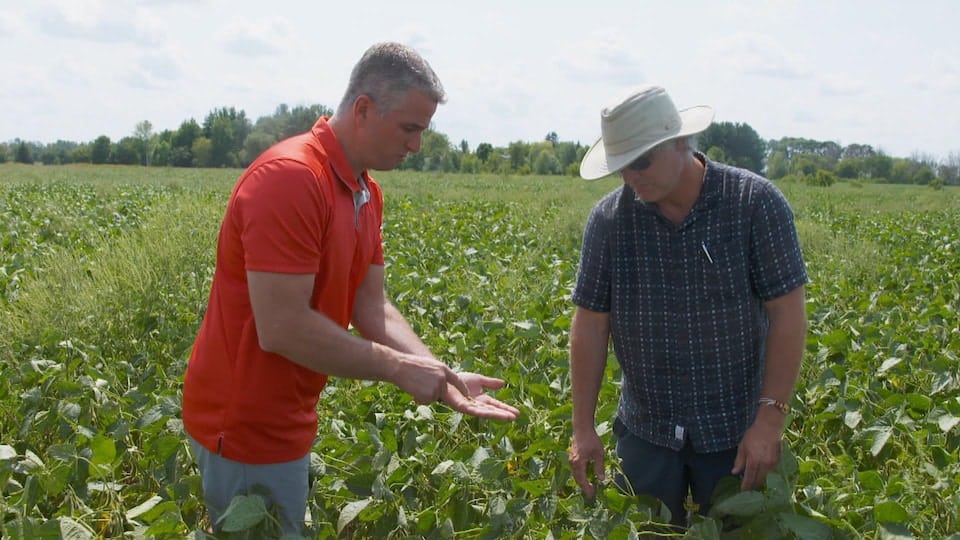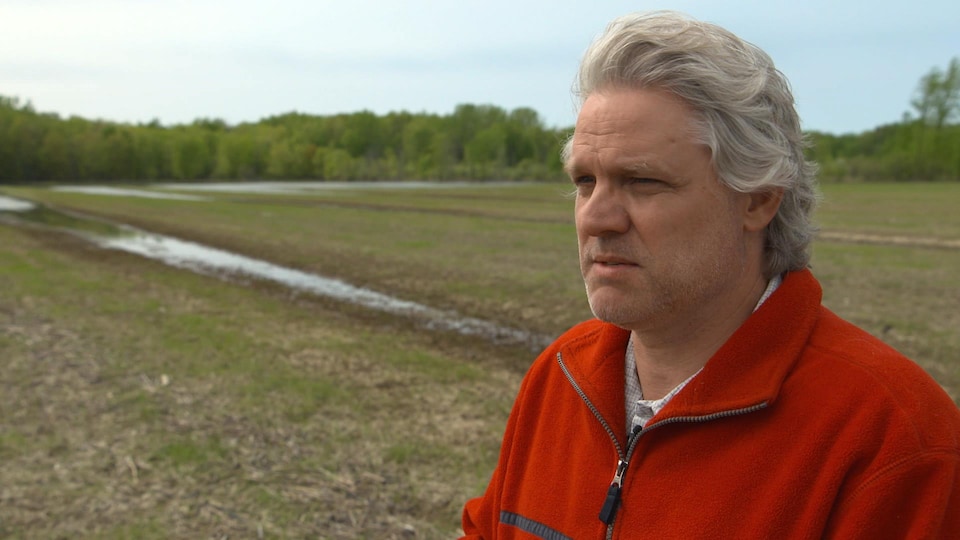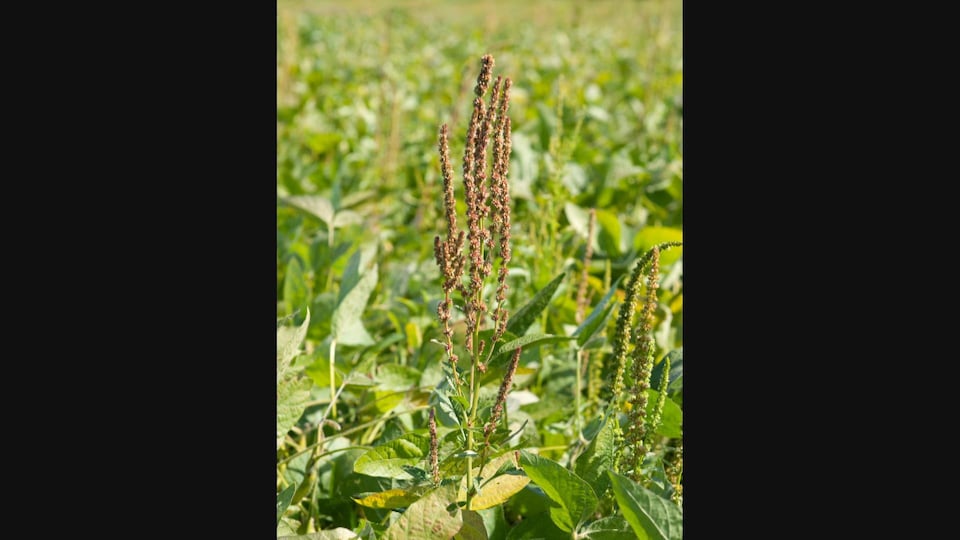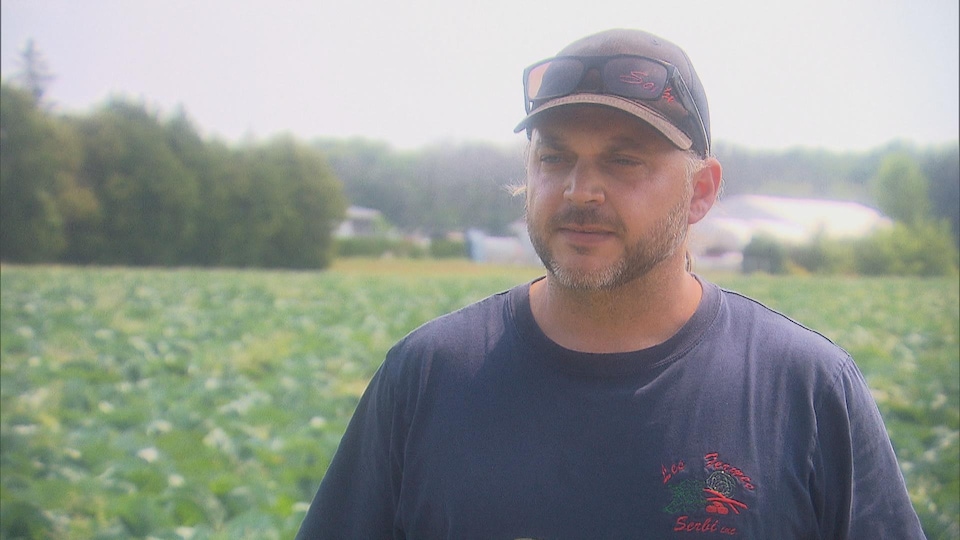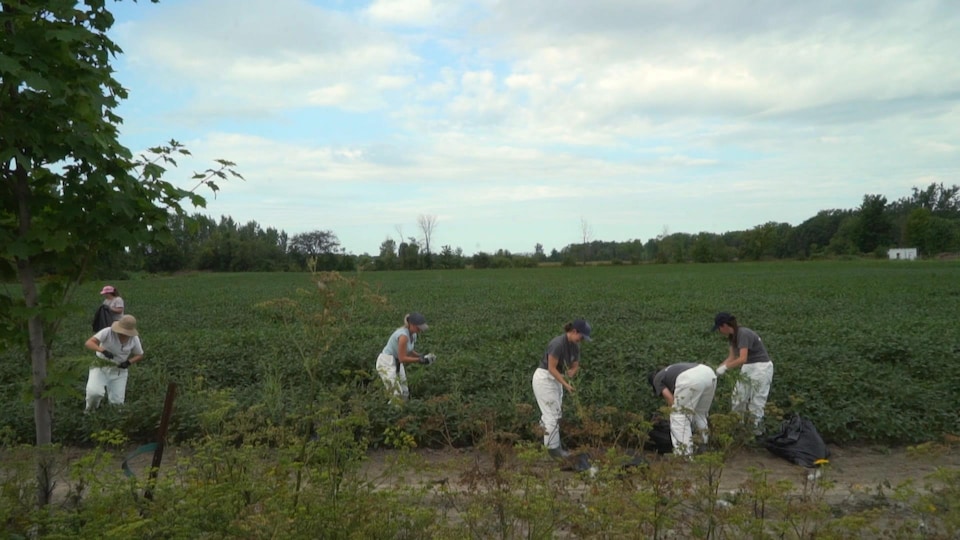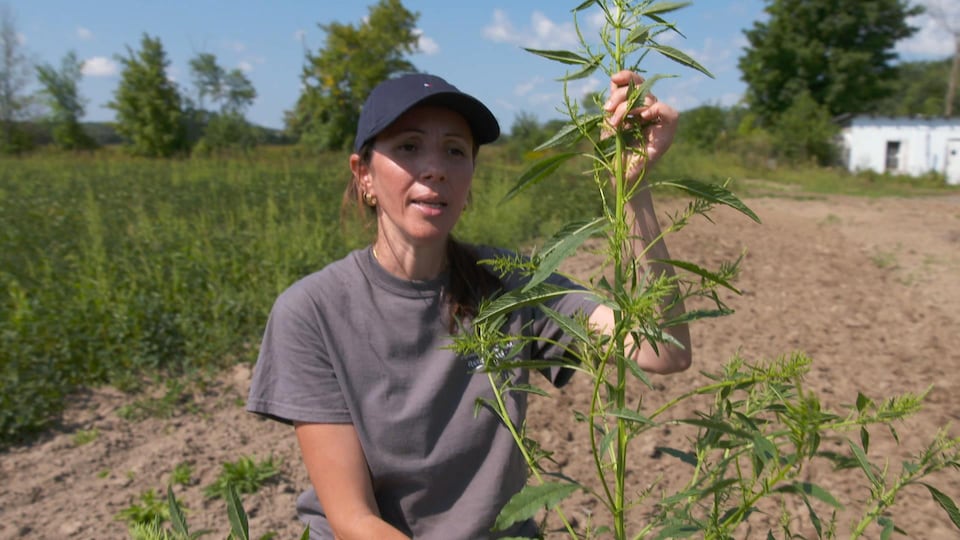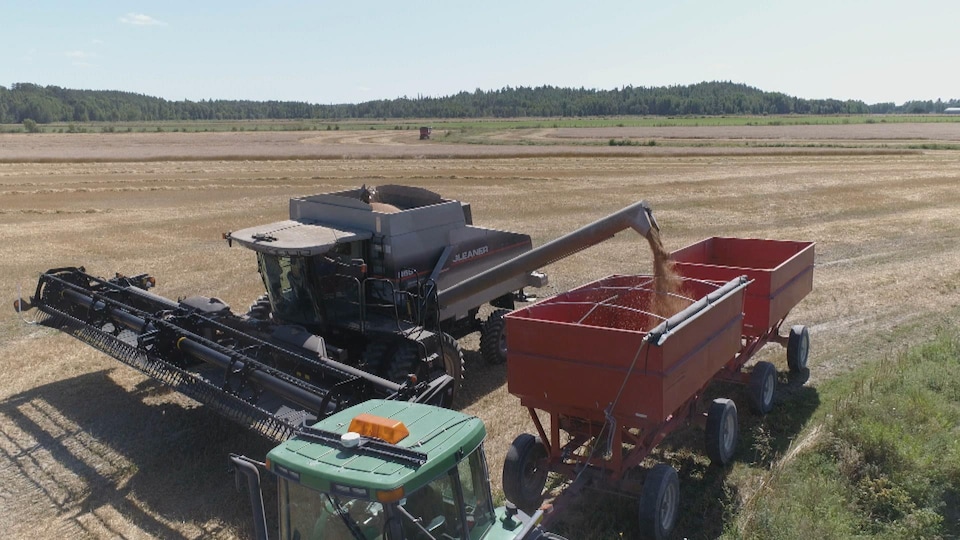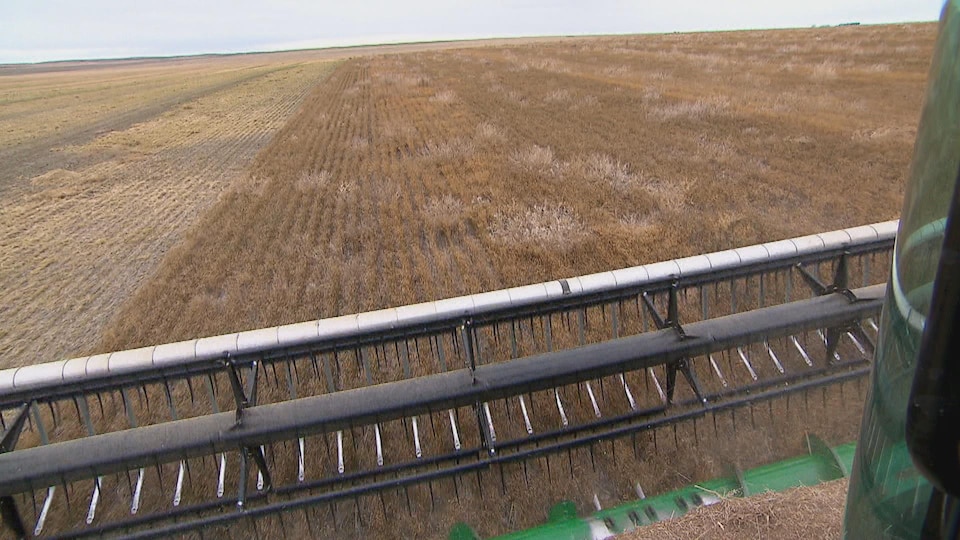Coming soon: Weeds genetically modified
and solutions to curb resistance
In the fields around here, we have resistant ragweed, so we have to learn to dealer with that
, explains producer Christian Brault. Despite two sprayings of herbicides, the ragweed proudly unfurls above the soybeans. Each plant can produce up to 3000 seeds which will carry the resistance.
Even if the two men take the opportunity to snatch the largest specimens in passing, the game is not won. Once it is there, we are taken with it, notes the farmer. We harvest, the machines move from one field to another, we talk about the birds, we talk about the wind… [et les semences se propagent].
Agronomist David Girardville is not surprised by the phenomenon of resistance to herbicides in plants. Of course, among the thousands of seeds there is one seed that will have the ability to resist. It is by chance that we will have a resistant seed. On the other hand, this weed, it will be multiplied by the repetitive use of the same herbicide.
Herbicide resistance appeared soon after the large-scale commercialization of these products, after the Second World War. As early as the 1950s, cases of resistance were recorded in the United States and Canada and over the past thirty years, they have multiplied.
The massive adoption of monocultures, which often require the same herbicides year after year, and the abandonment of rotations and grazing have exacerbated the problem. After the United States and Australia, Canada is the country with the highest number of cases of herbicide resistant weeds.
In Western Canada, resistance is estimated to cost farmers close to half a billion dollars each year. Until very recently, few cases had been identified in Quebec. I think that in Quebec, we underestimate the resistance a lot
says David Girardville. It is much more scattered. When you look for it, you find it almost instantly. It’s sad but it’s like that.
It is difficult for farmer Christian Brault to quantify the yield losses linked to resistant ragweed in his fields, but he is categorical: From the moment there is competition for water, nutrients, light, it is sure that it affects the culture.
Tuberculous amaranth, an enemy from afar
In Saint-Eustache, in the Laurentians, market gardener Sébastien Bigras does not hesitate for a second when asked about the financial impact of herbicide resistance. On his farm, he has been confronted with the phenomenon since the summer of 2020: I lost my two fields which were the most affected. So I can say that I had zero returns that year!
At home, it is a plant from the United States that poses a problem. Tuberculous amaranth is considered a super weed
. Able to germinate throughout the summer, it can grow 3 cm per day and is particularly prolific.
” On average, a female plant can produce 350,000 to 1 million seeds. In the literature, it is also said that when the right conditions are met, it can produce more than 4 million seeds. »
It was after spreading herbicides in his corn fields that Sébastien Bigras noticed plants that, against all odds, had survived. When we saw the problem, we absolutely mowed, because it was a carpet infested with tubercles.
In the summer of 2021, he used a cocktail of more expensive and more toxic herbicides to which amaranth is not yet resistant to get rid of it. We had to do three waterings, then my employees also went over the most problematic fields to remove the escapes that did not fall with the waterings.
The market gardener is far from being the only one to have to worry about this plant. Since the arrival of tuberculate amaranth in Quebec in 2017, around forty outbreaks of infestation have been discovered and it is in the Laurentians region that we have found the most.
A few kilometers from Sébastien Bigras’ farm, agronomist Fairouz Dif leads a small team which, in oppressive heat, sets about the colossal task of weeding a field of soybeans by hand. Our priority, the first year, must prevent the weed from producing seeds and reduce the seed bank as quickly as possible.
When the growth stage of the weed is too advanced, no herbicide is effective. The only option available to producers is manual uprooting.
During our visit, the Fairouz Dif team was on its second weeding chore in this field. In barely four weeks, the smallest piece of amaranth that had not been completely pulled out the first time has grown at breakneck speed. The amaranth has overtaken the soybeans and the plants are already in bloom. It is a profitable plant: when it finds the heat, the space between the rows, it grows, then it explodes!
illustrates Fairouz Diz.
What makes tuberculate amaranth particularly formidable is that it produces a lot of seeds, but above all it is resistant, not to one herbicide, but to several. Among the products that no longer have any effect on her is glyphosate, the most widely used herbicide in Canada, better known by the trade name Roundup.
Roundup is the cheapest on the market. It’s effective, but at some point the weed develops resistance and then the herbicide, glyphosate, it becomes ineffective
explains Fairouz Dif.
Of all the weeds, tuberous pigweed is one of the most effective at thwarting molecules designed to destroy unwanted vegetation. It will develop metabolic resistances, that is to say, naturally, it detoxifies herbicides
.
Agronomist at the Ministry of Agriculture, Fisheries and Food, Stéphanie Mathieu had never heard of this plant when it was first reported in Quebec. We did not expect it, the tuberous amaranth, at that time. It was a surprise.
An undesirable traveler
The plant is native to the American Midwest, where its multiple resistances cause a lot of damage. In 2014, she made her debut in Ontario. There, researchers have demonstrated the devastation it can wreak in soybeans in particular: yield losses of 43% on average, which can reach 100%, when amaranth is very competitive.
” If there are exchanges of machinery, custom threshing, that seed will be transported via the thresher, mainly to other producers. And then, the problem, it will be everywhere. »
In Quebec, it is via a used combine harvester, imported from the United States, that the plant would have arrived in 2017, in Montérégie. Three years later, used machinery still coming from the United States would be the source of another focus of infestation, in a region where it had been absent until then, Chaudière-Appalaches.
Although farm machinery must be cleaned before entering the country, border inspections are sporadic. And despite careful cleaning, a tiny seed can easily hide in these metal behemoths and travel thousands of miles.
Once in the country, it is again the machinery that promotes its spread. Not all companies are in a financial position to buy a combine harvester, we know that it is very expensive
emphasizes Stephanie Mathieu.
In the fall, many agricultural businesses retain the services of machinery owners who travel from farm to farm to perform custom harvesting work. At this time of year, their work is often like a race against time. Cleaning the machinery on leaving each field to prevent the spread of weeds is not realistic, according to Stéphanie Mathieu. It takes 5-6 hours to clean a combine from top to bottom. Clearly, the producers don’t have time to do that in the fall. We can think of rainy autumns, when they have a lot of areas to beat.
To counter resistance, MAPAQ strongly encourages farmers to do at least a cursory cleaning of machinery at the edge of the field. Biosecurity, clearly, is an issue
insists the agronomist.
Considering the nuisance potential of tuberculate amaranth, the ministry has released funds to curb its spread. For the past two years, nearly $7,500 per farm has been available to pay, in particular, the costs associated with manual uprooting. Unheard of, says Stéphanie Mathieu. Having financial assistance for uprooting was a first in field crops.
How do you know if a plant has developed resistance to a herbicide?
Visually, there is nothing to distinguish a resistant weed from a non-resistant weed. So you have to do some testing.
Until 2017, the only tests available were said classics
they needed harvesting seeds, growing the samples in the greenhouse and then subjecting these seedlings to the herbicide […] which takes a lot of time!
explains David Miville, agronomist-weed scientist at MAPAQ’s Phytoprotection Expertise and Diagnosis Laboratory.
Since 2018, there have been molecular tests, which are much faster. A sample I get in the morning, at the end of the day I have the results
, says the specialist. These tests do not require seeds, just a leaf sample. They can therefore provide answers much earlier in the season and trigger more targeted interventions in the field.
Tomorrow… weeds genetically modified
and solutions to curb resistance.
Catherine Mercier’s report is broadcast on the program green week Saturday at 5 p.m. and Sunday at 12:30 p.m. on ICI TÉLÉ. At ICI RDI, it will be Sunday at 8 p.m.
Reference-ici.radio-canada.ca
